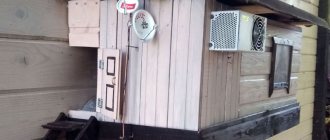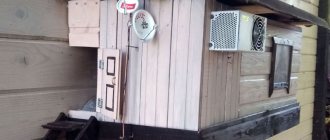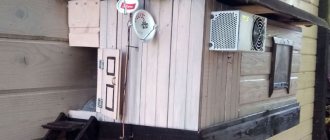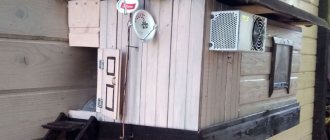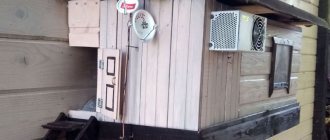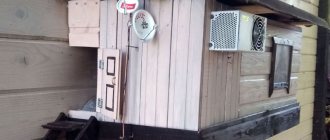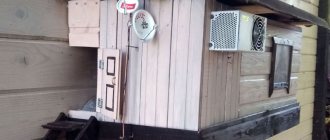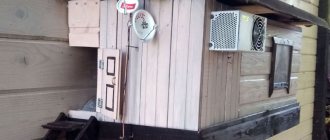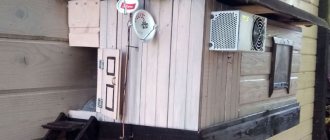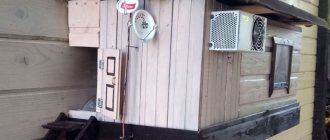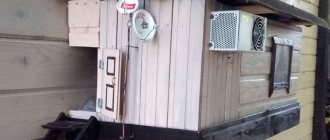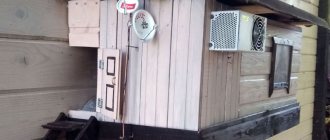Another homemade product for those who are bored at home
I needed a couple of antennas for digital, in places with “not the best reception”... I went shopping (this was before self-isolation - if it’s relatively budget-friendly, then it’s complete G. The more expensive one looks decent, but how it works is questionable.
- if it’s relatively budget-friendly, then it’s complete G. The more expensive one looks decent, but how it works is questionable.
I decided to make something homemade. It was somehow awkward to “twist” an antenna from a piece of cable (although rumor has it it works) - I wanted something simple, but more decent and advanced
In fact, the one I made is not radically more complicated, but somehow more “solid” or something. And the results of its testing were very encouraging, so I decided to sketch out a short description of what and how, in case someone else finds it useful 
... even if my street cats have a “normal” antenna on their house, what can you do without an antenna?!
The wire is not all finished yet, now we’ll assemble something!
In the places described, I previously used home-made broadband log-periodic antennas, probably since the “beginning of perestroika.” They worked well in analog and not only on UHF, but “for some reason, digital was too tough for them.” I didn’t really delve into the essence of the reasons, I removed them and began to think about what to replace them with. Here is one of them, waiting for a place in the trash
They worked well in analog and not only on UHF, but “for some reason, digital was too tough for them.” I didn’t really delve into the essence of the reasons, I removed them and began to think about what to replace them with. Here is one of them, waiting for a place in the trash
A little history
In the early 60s of the last century, our compatriot Kharchenko K.P. developed a simple flat zigzag antenna with good characteristics.
Copyright certificate No. 138277 for an invention called “Band directional antenna” was issued to Konstantin Pavlovich Kharchenko in 1961 (according to his application dated June 16, 1960). In the same year, materials were published in the magazine “Radio” for repetition by radio amateurs.
The antenna is not critical to materials and dimensions during manufacturing, has a simple good match with the reduction cable, and it successfully combines multiple elements of a common-mode antenna array with a single feed point.
Theory and calculations
The described antenna, in theory, has a horizontal “figure-of-eight” radiation pattern and a relatively high gain, which can be further increased by using a reflector/reflector.
To obtain maximum gain on all channels, it is necessary to make an antenna approximately in the middle of the range between the multiplexes used.
Finding (for calculations) the frequencies of multiplexes used in your region is easy,
for example, a request like “dvb-t2 channel frequencies” + “Krasnodar”
I found something like this:
The middle, between “my” two multiplexes, is 700 MHz - we will calculate the antenna at this frequency.
As a basis for calculating the dimensions of the antenna, we take the drawing of its author
Calculate the wavelength: λ = 300 / f [m]
300/700 = 0.428m, approximately 43cm length of each side of the rhombus
λ/4
=43/4= 10.75
The total length of the material we need (11cm*8=88cm) is less than a meter. The distance between the reduction contacts, where we will solder the cable, is 10-12mm (the standard value for this antenna for frequencies below 900 MHz).
I will make a simple antenna, without a reflector, however, to further increase the gain of this antenna, it is quite possible to install it behind it
for example, from a metal mesh/grill, foil material or simply a metal plate. Its dimensions should be approximately 20 percent larger than the dimensions of the antenna and it should be located at a distance of ƛmax/7. For my case: wavelength (channel 39) 300/618, it turns out...49/7= that is, about 7cm
For those who are too lazy to do the calculations themselves
— you can use an online calculator, the results will differ only slightly from those I received. Here, for example, this one - here you immediately enter the frequencies of two multiplexes and get the dimensions of the antenna (without a reflector) Or another option, with a reflector - I really want to note that in the second option a slightly different calculation option is used, different from the author’s. An antenna with angles other than 90° is assumed and the reflector distance is calculated as λ/8
To make the antenna sheet, it is recommended to use aluminum or copper (copper is easily soldered) with a diameter of 3 mm and higher - the larger the diameter, the more broadband the antenna is. You can use tubes; the thickness of the walls is not important, since only the surface of the material is used (in fact, you can wrap any dielectric with foil to obtain the required material). However, in my opinion, the easiest way is to buy a meter of large-gauge copper wire at an electrical supply store.
How to connect to a public antenna and set up digital channels
After digital television is brought into the apartment via a collective antenna, the subscriber should immediately attend to the wiring of the internal network. Its circuit includes signal dividers and amplifiers, if necessary, to ensure a good level at distant connection points. The wiring looks like this:
- the cable entering the apartment is connected to the input of a simple splitter;
- from the two outputs of the divider the signal goes to TVs in separate rooms;
- A separate cable is supplied to each TV.
There can be more than one divider in a circuit. For example, two, if you need to send a signal to three rooms of the apartment. The network needs to be planned in advance. In this case, service company specialists can configure cable television equipment in an apartment building so that a sufficiently high signal is supplied to the port of a particular subscriber. This will allow you to get an excellent picture on all connected TVs, even with dividers.
To set up digital channels through a common house antenna, the user will need a modern TV with a DVB T2 tuner or a separate set-top box for each imaging device. It is better to find out how to search for available broadcasts in the operating instructions for the installed equipment. In general, the algorithm looks like this:
- the TV OSD menu is called up;
- you need to go into settings;
- go to the “Channels” section;
- start an automatic search and wait for it to finish.
Important!
After this, you almost always need to sort the channels. The fact is that digital television through a collective antenna can include many paid broadcasts. If desired, if the service company provides such an opportunity, you can subscribe to them for a fee. It is worth remembering that in practice the range of paid channels is quite scarce. Unlike the offers of cable television providers, where there are many packages and thematic selections. But if you plan to receive only 20 free federal channels from your home antenna, you need to conduct a search and remove unnecessary programs from the list.
Antenna assembly
Let's remove the insulation from a piece of wire one meter long.
I got a wire with a diameter of 4.5mm
The tools you will need are a vice and a hammer. Measure approximately 11cm each and bend at an angle of 90°
The end result is to get such a “geometric” figure 
We cut off the excess and solder the ends. It should look something like this...
Solder the cable as shown in the photo.
We lay the cable along one side of the square and secure it with clamps. This arrangement of the cable is necessary for its coordination (there are different opinions, not everyone agrees with this statement).
When using a reflector, the antenna sheet at the extreme points of the squares can also be secured using metal stands, for example, soldered onto the remains of the same copper wire - there are points with zero potential (highlighted in green). In other places, fastening is allowed only through a dielectric.
Testing a homemade antenna on a homemade TV
So a biquadrate gives a signal amplification of about 6 dB, and the distance to the tower is 26 km in a straight line. Although the CETV website indicates that we are in the zone of a reliable signal, I doubted it and prepared a two-stage homemade DVB-T2 (UHF) signal amplifier .
I went up to the second floor of the house and pulled the antenna onto the scaffolding. He pointed towards the tower and turned on the TV. The TV confidently accepted both digital TV packages.
I brought the homemade antenna into the house, the TV continued to confidently show perfectly.
Then I brought my homemade TV into the change house, and hung the antenna inside the change house on the door. The TV continued to receive the signal reliably.
You can also make a Kharchenko biquad antenna for 3G, 4G or Wi-Fi, you just need to convert it to the appropriate frequency.
Tests
And finally, a performance check and a rough
assessment of the quality of the resulting antenna.
In fact, everything is simple with the test - turn it on, it works! And to evaluate whether the game was “worth the candle,” let’s compare the parameters of the received signal from the manufactured antenna with the one I’m already using at the dacha, with a declared gain of 11dBi
And to evaluate whether the game was “worth the candle,” let’s compare the parameters of the received signal from the manufactured antenna with the one I’m already using at the dacha, with a declared gain of 11dBi
The antenna is installed in the attic of a country house, at a distance of approximately 16 km from the tower.
Signal level: factory stationary antenna on the left / homemade on the right
At first glance, the difference is only 1% (95 versus 94) - but this is not a completely correct comparison, since my external antenna is connected through a splitter, which further weakens the signal.
Why can't I get free channels from a common antenna?
In theory, connecting and setting up digital channels through a common house antenna is quite simple. In practice, it happens that the user already has a cable in his apartment. After organizing an internal network, connecting a TV or set-top box, the subscriber discovers that he does not have a DVB T2 number as such. This often happens in several cases.
Cable TV provider network
It happens that there is a terminal box for the television cable in the entrance, but it is not possible to receive channels in DVB T2 format from it. The user's TV finds many analogue broadcasts, several radio stations and a DVB C signal. This means that the house is connected to one of the cable TV providers.
Important! If cable TV is installed at the entrance instead of a regular house antenna, nothing can be done about it. There are many channels on the user's TV, but they are all encrypted. There may not be any free ones at all.
To use cable television, you will have to enter into an agreement with a provider. It won't be possible to do without this. Even if the person connected to the box in the entrance is satisfied with the available set of channels, he will not be able to use it. Cable TV provider specialists periodically check the status of connections and simply cut off the unauthorized connection.
A contract with a cable TV service provider can mean two things:
- the need to buy a fairly expensive package of basic channels;
- purchase or rent a set-top box that works with a smart card to decode the stream.
Once the automatic channel search on your TV or tuner is completed, finding out the name of your cable TV provider will not be difficult. Usually it is indicated directly in the name of the broadcast. This company should be contacted to obtain sufficient information to make a decision on connecting services or refusing such a step.
Very old communal antenna
In modern new buildings, service companies install digital antennas or immediately install a cable television provider’s network. Old buildings do not have this luxury. An antenna installed on the roof simply physically cannot receive digital broadcasts in the UHF wavelength range.
Assessing the performance of the antenna
Let's try to make a more correct comparison by connecting through the splitter input.
Well, in addition, for clarity, let’s add the number of participants List of antennas taking part in the comparison:
1. External antenna Funke BM 4551 external long-range,
declared gain, from some sources (bought at Yulmart), up to 16dB
2. There is an old UHF loop antenna, from TV Electronica 313d, I must say, despite its simplicity, it’s a very good antenna, that’s why it’s been preserved 
3. I went to the store and bought for comparison in the review one of the cheapest, such as a symmetrical vibrator (100% the most purchased by pensioners, due to the low price).
I will carry out all “measurements” at one point, located as close as possible to the external antenna - its location was experimentally selected based on the maximum signal, so we can say that the conditions are approximately the same
So, we have already seen the signal level from the external antenna at 95% (at the time of current measurements it showed 94%), we take it as a standard. All comparisons are made by connecting antennas to the input on the splitter, to which an external antenna is usually connected.
Loop antenna, from Electronics 82% on 39 multiplex and 66% on 60
Budget with “horns” - 62%/38% (on the verge of losing the broadcast)
- 62%/38% (on the verge of losing the broadcast)
Double square - 92% on both multiplexes, about a couple of percent less than the external one
Out of curiosity, I decided to check the work of the reflector, which is easy to make from any metal mesh, plate or even foil... It REALLY works noticeably! The level rose to 96%!, which is even higher than the stationary one, with a declared gain of 11dB.
The most interesting thing is the object that I used as a reflector! 
There was no foil in the house; the only thing available with a metal surface of the required size was... a laptop cover (I have a metal case). But the main thing is the result! It’s clear that I’m not going to “tie” the laptop to the antenna, and its amplification is enough for me without a reflector
What to do if you only want DVB T2
In the above cases, the user finds himself in an unpleasant situation. He cannot get optimal conditions and is forced to accept restrictions or pay for cable TV.
But there is an alternative. An antenna for individual digital TV reception can be installed on a balcony, near a window, or on the roof. Even inside the apartment, if it is located near the base station. The main thing is to choose the right device. The DVB T2 antenna will pay for itself fairly quickly. It will allow receiving at least 20 free channels in large cities and about 10 in remote regions with undeveloped base station infrastructure.
Conclusion:
I can confidently recommend repeating it!
Simple, “cheap and tasty”... One of the simplest, indoor antenna mounts... with ordinary suction cups - if you’re lucky with the direction to the television center
The next antenna "recommended for repetition" is... log periodic
“Crazy hands” were with you. Good luck and good mood to everyone! ☕
Good luck and good mood to everyone! ☕
